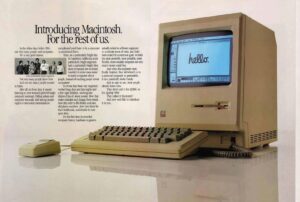
As far as distributing the Future, there has been nothing more fundamental, in at least the last half century, than the Macintosh computer. As 1984 dawned, the Future of computing was, in fact, already here, but it was very unevenly distributed. Apple billed the Macintosh as “The Computer for the Rest of Us,” and that’s exactly what it turned out to be.

Mainstays like a graphic user interface, a mouse, icons, a “desktop,” networking and many other concepts we take for granted on our computing devices had already been invented and were starting to see the light of day, but only for a select few. Xerox had most of them in its lab, and Apple had even made an initial attempt to distribute them more widely through its ill-fated Lisa Computer (available in 1983 for the low low price of $10,000, or over $30,000 in today’s money).
But it took the Macintosh, “the Computer for the Rest of Us,” to foster, if not become, the computer for the rest of us. Not only did it make the Future of computing semi-affordable ($2500, still nearly $8000 in today’s dollars), but it set a standard which IBM, Microsoft and most other computer manufacturers saw they had to live up to. So whether you, your office, or your school bought a Mac or an “IBM clone” running Windows, you got to see the Future.
The Macintosh, and Apple, have been using this model ever since: making an already-here, but very-unevenly-distributed Future more affordable and accessible for the rest of us. They even outdid themselves 20+ years after the Macintosh, with a little device called the iPhone. Stay tuned.